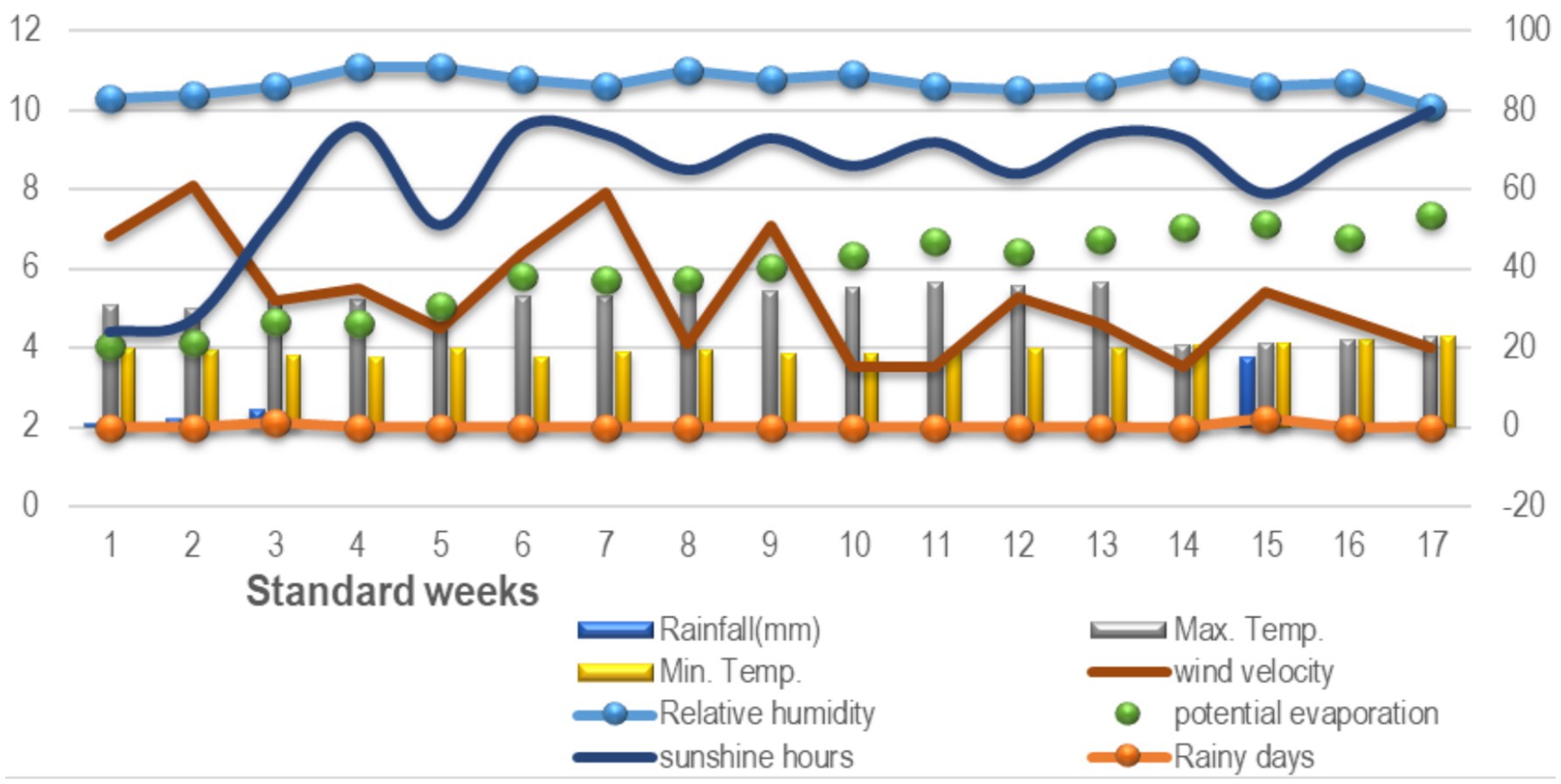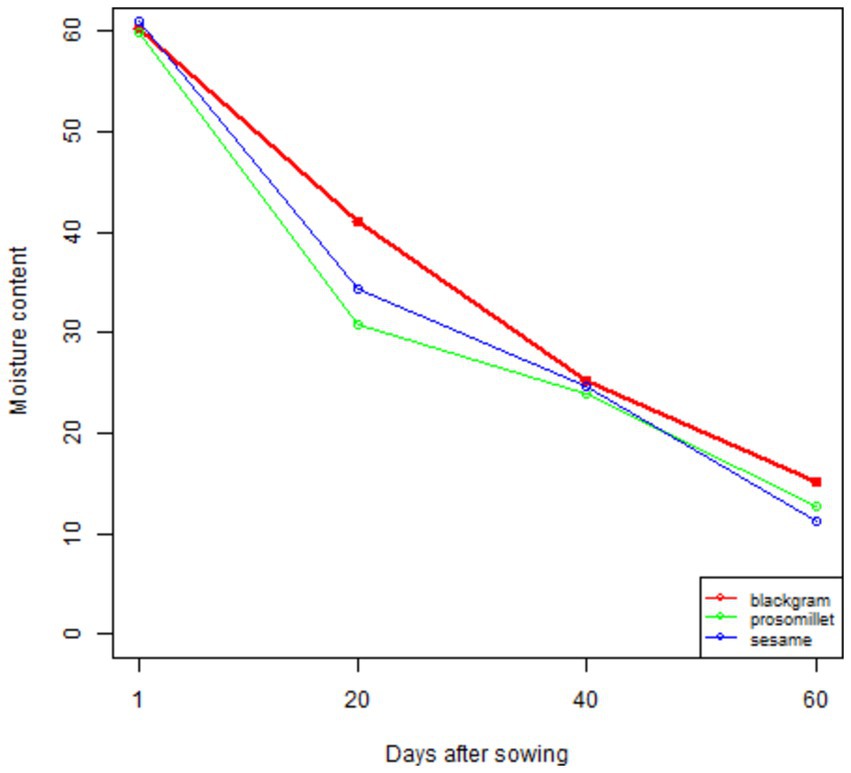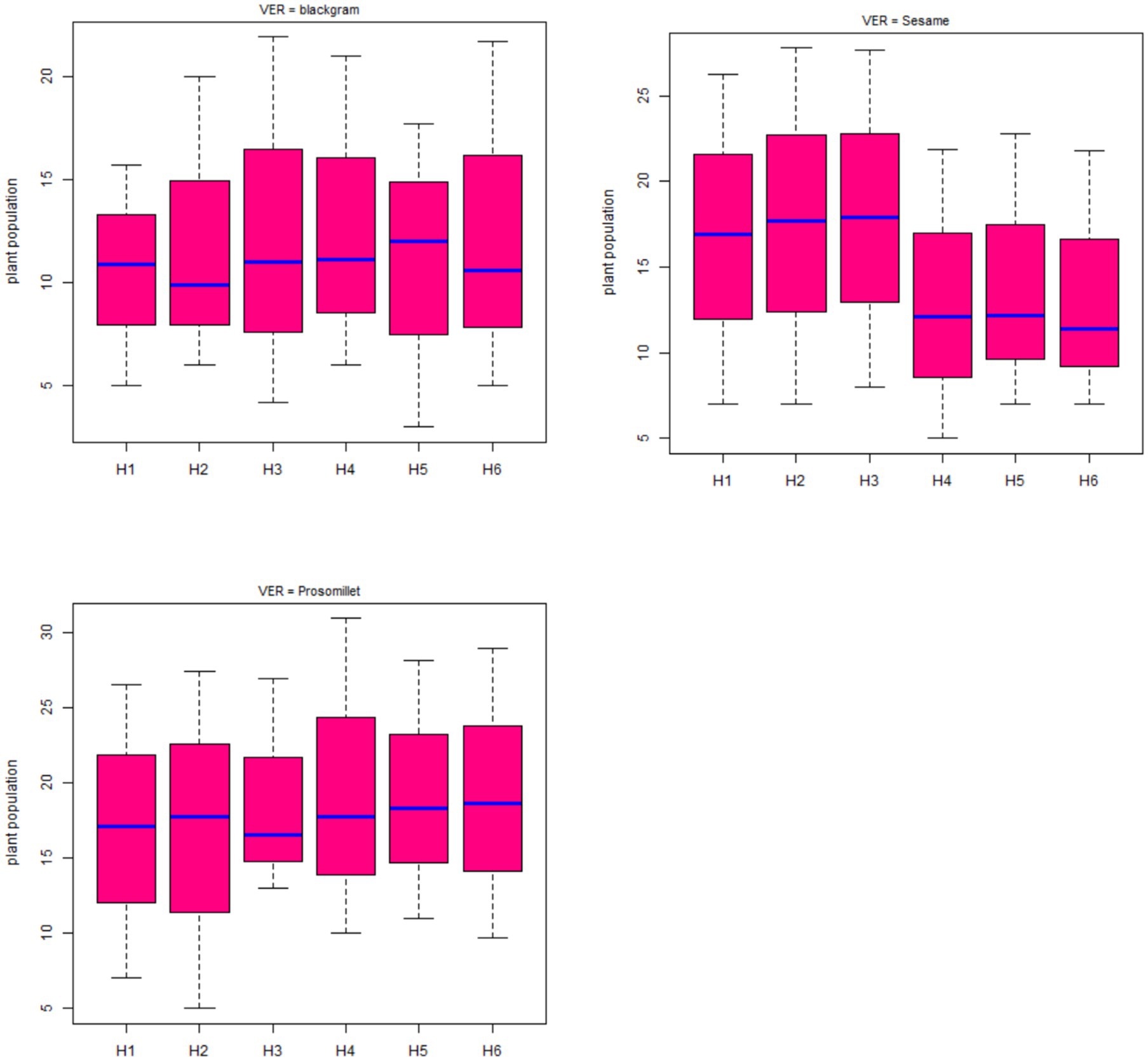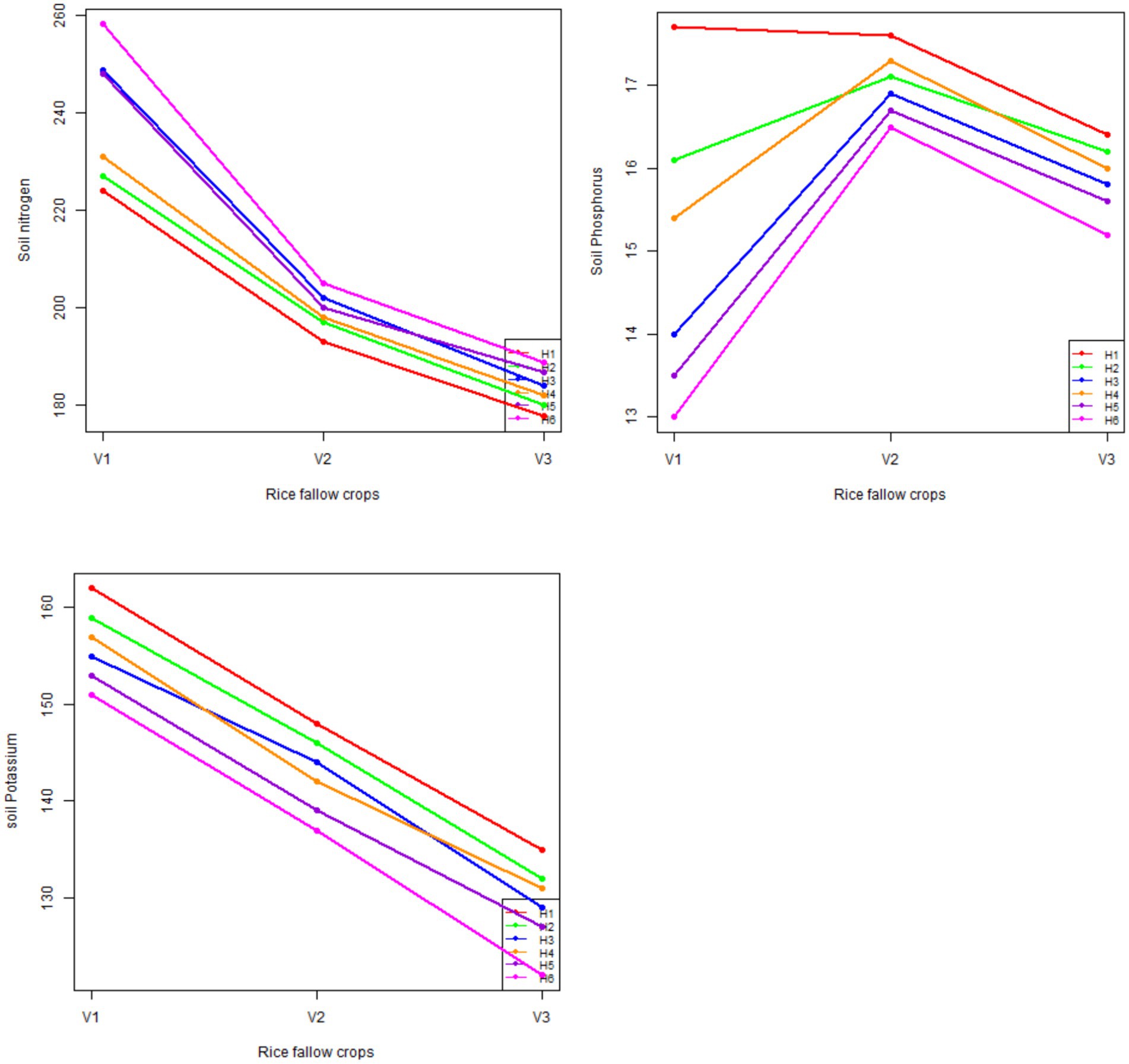- 1Department of Agronomy, Agricultural College and Research Institute (AC&RI), Tamil Nadu Agricultural University (TNAU), Madurai, Tamil Nadu, India
- 2ICAR- Krishi Vigyan Kendra, Tamil Nadu Agricultural University (TNAU), Madurai, Tamil Nadu, India
- 3Department of Plant Breeding and Genetics, Agricultural College and Research Institute (AC&RI), Tamil Nadu Agricultural University (TNAU), Madurai, Tamil Nadu, India
- 4Department of Soil Science and Environment, Agricultural Research Station, Tamil Nadu Agricultural University (TNAU), Kovilpatti, Tamil Nadu, India
- 5Department of Agricultural Extension and Rural Sociology, Agricultural College and Research Institute (AC&RI), Tamil Nadu Agricultural University (TNAU), Madurai, Tamil Nadu, India
- 6Food Science and Nutrition, ICAR- Krishi Vigyan Kendra (KVK), Madurai, Tamil Nadu, India
A field experiment was conducted at the Department of Agronomy, Agricultural College and Research Institute, Tamil Nadu Agricultural University, Madurai to study the performance of rice fallow crops in machine-harvested rice fields. The primary objective of this study was to determine the optimal seed rate and the time of sowing rice fallow crops in machine-harvested rice fields. Rice fallow crop cultivation is the most significant low-cost production system in the delta region. However, the sustainability of the system is uncertain in the context of mechanical harvesting of rice using heavy machinery. The crops selected for the experimental trial were black gram (Vigna mungo (L.) Hepper.), sesame (Sesamum indicum), and proso millet (Panicum miliaceum). The field experiment was conducted using a strip plot design. Rice fallow crops were arranged in vertical plots, while various seed rates and sowing timings were arranged in horizontal plots. The results indicated that the sowing time and seed rate significantly influenced the growth and development of rice fallow crops in machine-harvested rice fields. On the day of rice harvest, a 20% increase in seed rate (36 kg ha−1) resulted in greater grain and straw yield among the black gram treatments. The increased seed rate compensated for the damage caused by mechanical harvesting on the day of the harvest when a combine harvester was utilized, increasing the yield and sustainability of the rice fallow crops.
1 Introduction
Rice is the cornerstone of Indian agriculture, accounting for 46.2 m ha of cultivated area and producing 130.4 mt. A single rice crop, typically grown from August to January and using long-duration rice varieties (155–165 days) and medium-duration rice varieties during the rabi season, is harvested during the first fortnight of January and celebrated as a harvest festival in South India and the rest of India. The “Rice Fallow Pulses” in the delta region are cultivated regularly after the rice crop in Tamil Nadu from January to March, encompassing a total area of 2.0 lakh ha and contributing significantly to pulse production in the state. Pulses, particularly black gram or green gram, are traditionally sown 7–10 days before the harvest of rice under zero tillage conditions by utilizing the residual soil moisture. The germinated pulse crop withstands disturbances during manual harvesting of rice and thrives under paddy stubble, which provides a favorable microenvironment. However, the yield of rice fallow crops during this period typically ranges from 300 to 500 kg ha−1, which is significantly lower than the potential yield achievable under irrigation (Umamageswari et al., 2019).
The productivity of rice fallow crops is generally impeded by various factors, including biological and environmental stresses, inadequate crop management practices, and socioeconomic limitations. The most significant constraint for rice fallow crops is low soil moisture content after paddy harvest, along with a lack of irrigation facilities (Kumari and Rahaman, 2021). Among these factors, soil and water availability emerge as primary constraints contributing to low yields. With irrigation typically withheld 10–15 days before rice harvest, soil moisture rapidly diminishes as the crop cycle progresses. A notable period occurs in the second half of February, when an increase in the temperature exacerbates moisture stress, significantly impacting fallow crops during the flowering and pod development stages.
Early maturity, rapid growth, early ground cover, and deep roots have been recommended as desirable plant characteristics for water-limited rice fallow conditions (Bandyopadhyay et al., 2016; Hazra and Bohra, 2021). Ensuring an optimum plant population is essential for increasing yields in rice fallow pulse cultivation. Research suggests that diversifying rice fallows with short-duration pulses or oilseeds is a viable option for horizontal expansion, while also increasing productivity and profitability. This approach also facilitates the growth of soil organic carbon (SOC), nutrients, and microbial populations through nitrogen fixation, leaf shedding, and higher biomass accumulation (Gautam et al., 2021). In addition, pulses facilitate soil health restoration by fixing atmospheric nitrogen (N) and increasing crop biomass, which improves the soil organic carbon (SOC) status (Geethika et al., 2024).
Traditionally, seeds are distributed manually 7–10 days before the paddy harvest, when soil moisture is optimal. However, this method often results in challenges, such as uneven germination and plant distribution. Furthermore, the transition to machine harvesting of paddy has introduced an additional challenge, as machinery may inadvertently damage emerging pre-harvest sown crop plants through trampling during the paddy harvest. As mechanized harvesting becomes more prevalent, it not only alters soil physical conditions but also disturbs the soil moisture status in rice fallow cultivation. Consequently, rice fallow pulses are predominantly restricted to this region, and farmers are reluctant to cultivate rice fallow crops in machine-harvested rice fields. In response to these challenges, the present study was conducted to evaluate methods for mitigating mechanical damage and moisture stress as well as for enhancing crop establishment, ultimately aiming to increase the productivity of rice fallow crops.
2 Materials and methods
2.1 Experimental site
A field experiment was conducted during the rice fallow season of 2024 at the Agricultural College and Research Institute, Tamil Nadu Agricultural University, Madurai, Tamil Nadu. The study area has a subtropical climate characterized by distinct wet and dry seasons, with an average annual rainfall of 970 mm. The weather parameters of the experimental site are shown in Figure 1. The mean maximum temperature reaches up to 35.2°C, the minimum temperature drops to 18.9°C, and the pan evaporation rate is 5.2 mm, with relative humidity ranging between 45 and 82%.
2.2 Treatment design
A total of 18 combinations were evaluated, including three vertical strips and six horizontal strips. Rice fallow crops—V1: black gram, V2: sesame, and V3: proso millet—were arranged in vertical strips. The time of sowing and seed rate for rice fallow crops were as follows: H1 - recommended seed rate 7 days before harvest (RSR @7DBH), H2 - recommended seed rate 1 day before harvest (RSR@1DBH), H3 - recommended seed rate on the day of rice harvest (RSR on DRH), H4–20% increased seed rate 7 days before harvest (20%ISR @7DBH), H5–20% increased seed rate 1 day before harvest (20% ISR @ 1DBH), and H6–20% increased seed rate on the day of rice harvest (20%ISR on DRH). The treatment combinations were replicated three times. The experimental soil texture was sandy loam with a pH value of 7.6, organic carbon content of 0.47%, medium-available nitrogen (212 kg ha−1), available phosphorus (14 kg ha−1), and medium-available potassium (189 kg ha−1). Black gram ADT 6, sesame VRI 5, and proso millet ATL 1 were utilized as test varieties. The seeds were broadcast uniformly throughout the field manually as per the treatment protocol. Data on crop growth and yield attributes were recorded, with seed yield measured in kg plot−1 and converted to kg ha−1. Soil profile moisture depletion was assessed using the gravimetric method, with soil cores extracted at 0–5, 5–10, and 10–15 cm depths on the day of sowing, 30 days after sowing (DAS), and at harvest.
2.3 Experimental design
The experiment used a strip plot design with three replications and a plot size of 5 × 5 m for each combination of the rice fallow crops. To facilitate efficient drainage for each plot, 0.5-m wide irrigation channels were established between each strip. All agronomic practices, including plant protection and fertilizer management, were implemented according to the established agronomic protocols (Chandrasekaran et al., 2010). As the seeds were sown with a standing crop of rice, treatments were applied to the respective plots during the last stage of field preparation, according to the schedule. Statistical analysis was conducted following the method proposed by Gomez and Gomez (1984).
2.4 Biometric observations
The morphophysiological traits and growth attributes of rice fallow crops were examined. The survival rate of the crops after the standing rice crop was harvested with a combine harvester was also determined. Five plant samples were randomly selected from each plot at different phenological stages, specifically 20 and 60 days after sowing (DAS), to assess the impact of various seed rates and sowing times on the growth and yield of rice fallow crops. During sample collection, precautions were taken to prevent root damage. The shoot and root lengths of the selected plants from each plot were measured using a measuring scale. Moreover, 20 days after sowing, the plant density per unit area was determined.
2.5 Moisture content estimation
Soil moisture availability was measured using oven drying methods on the day of sowing, as well as at 20 and 60 days after sowing (DAS).
2.6 Estimation of soil nutrients
Soil samples were collected from each plot before land preparation and after harvest during the cropping season. Soil samples were obtained at a depth of 15 cm, shade-dried, and subsequently transported to the laboratory for further analysis. The quantities of available nitrogen (N), phosphorus (P), and potassium (K) were determined using the modified macro Kjeldahl method (Model KELPLUS Elite EXVA) (Gangopadhyay et al., 2022), the Olsen method (Olsen, 1954), and the flame photometer method (Black et al., 1965), respectively.
2.7 Statistical analysis
Two-way ANOVA was used to determine the significant differences in crop growth characteristics, yield attributes, and yields among the various treatment combinations. All statistical analyses were performed using R statistical software.
3 Results and discussion
3.1 Soil available moisture
Rice fallow crops are cultivated with residual moisture beneath the soil and supplemented with dew during the cropping season. During the rice fallow season, irrigation facilities are typically unavailable, and rainfall is scarce. Therefore, crop growth and development depend on the effective utilization of carryover residual soil moisture (Kar and Kumar, 2009). The results of moisture content estimation revealed that the moisture content of the soil was approximately 60.3% at the time of sowing and gradually decreased to 36.7 and 16.5% at 20 and 60 DAS (days after sowing), as shown in Figure 2. Severe stress inhibits both legume dry matter accumulation and proportional dependence on symbiotic N fixation as a source of N (Gull et al., 2020). Moisture depletion of up to 53.6% was recorded because it did not affect the growth of black gram, which matures at 60 DAS and is resistant to moisture stress. Midseason drought and heat stress can lead to early maturity and a reduction in grain yield by 50% in the tropics. This is more pronounced in the absence of rainfall during the fall or winter (Ali, 2015). The trend in the soil moisture content revealed that the soil retained a high moisture content due to ground cover by black gram, whereas the decrease in the moisture content in sesame and proso millet was predominantly due to less ground cover, mainly from narrow and erect leaves. Therefore, black gram is considered an ideal plant type for growing under rice fallow conditions.
3.2 Growth attributes
Data on the growth attributes of black gram, sesame, and proso millet indicated that plant population was higher in rice fallow black gram than in sesame and proso millet (Figure 3). The black gram with a 20% increase in the seed rate sown on the day of paddy harvest with the combine harvester had the maximum plant population m−2 (29.3 plants), which was comparable to the recommended sowing rate of black gram on the day of paddy harvest with the combine harvester and the sowing of black gram with a 20% increase in the seed rate a day before rice harvest. The ideal plant population for black gram is 32 plants m−2, and the tested treatment, which included a 20% increase in seed rate on the day of harvest, produced results similar to those recommended. In the case of sesame, the plant population increased with a 20% increase in seed rate on the day of paddy harvest using a combine harvester. Unlike manual harvesting, machine harvesting of paddy causes damage to establishing pulse plants due to the trampling effect of wheels during field traversal (Subrahmaniyan et al., 2023). Crop establishment was poor, with proso millet (V3) being sown on the day of paddy harvest. The plant population per unit area was greater when the broadcasting method was used, as opposed to using seed drills in rice fallow for black gram (Amuthaselvi et al., 2019). Regardless of the type of crop, sowing on the day of rice harvest was found to be superior in terms of greater plant population. Therefore, in future, it may be feasible to carryout the sowing of rice fallow crops at the time of harvest.
A taller plant was obtained by sowing a 20% increase in the recommended rate of black gram seeds on the day of rice harvest at 20 DAS (13.7 cm) and 60 DAS (34.7 cm). Similarly, a taller sesame plant was obtained by sowing a 20% increase in the seed rate on the day of rice harvest at 20 DAS (23.4 cm) and 60 DAS (82.3 cm). Shorter plants were observed when the recommended seed rate of sesame was sown 7 days before rice harvest at 20 DAS (20.5 cm) and 60 DAS (79.4 cm). Taller proso millet plants were obtained by sowing a 20% increase in seed rate on the day of rice harvest at 20 DAS (1.83 cm) and 60 DAS (17.8 cm). The shorter plant observed in the proso millet was sown at the recommended seed rate of sesame 7 days before the rice harvest at 20 DAS (16.0 cm) and 60 DAS (34.5 cm) (Table 1). The moisture conditions provided by rice residue enhanced the growth of black gram during the early stages. The leaf area index was greater with a 20% increase in seed rate on the day of paddy harvesting with the combine harvester for all three rice fallow crops: black gram (1.42), sesame (1.83), and proso millet (1.98). This was followed by sowing the rice fallow crops with a 20% increase in seed rate a day before rice harvest in black gram (1.39), sesame (1.77), and proso millet (1.78). The leaf area index was found to be lower when the recommended seed rate was sown 7 days before the rice harvest in the rice fallow crops. The growth characteristics of the rice fallow crops indicated that sowing black gram with a 20% increase in seed rate on the day of the harvest was the ideal combination for effective ground cover and improved growth of the rice fallow crops.
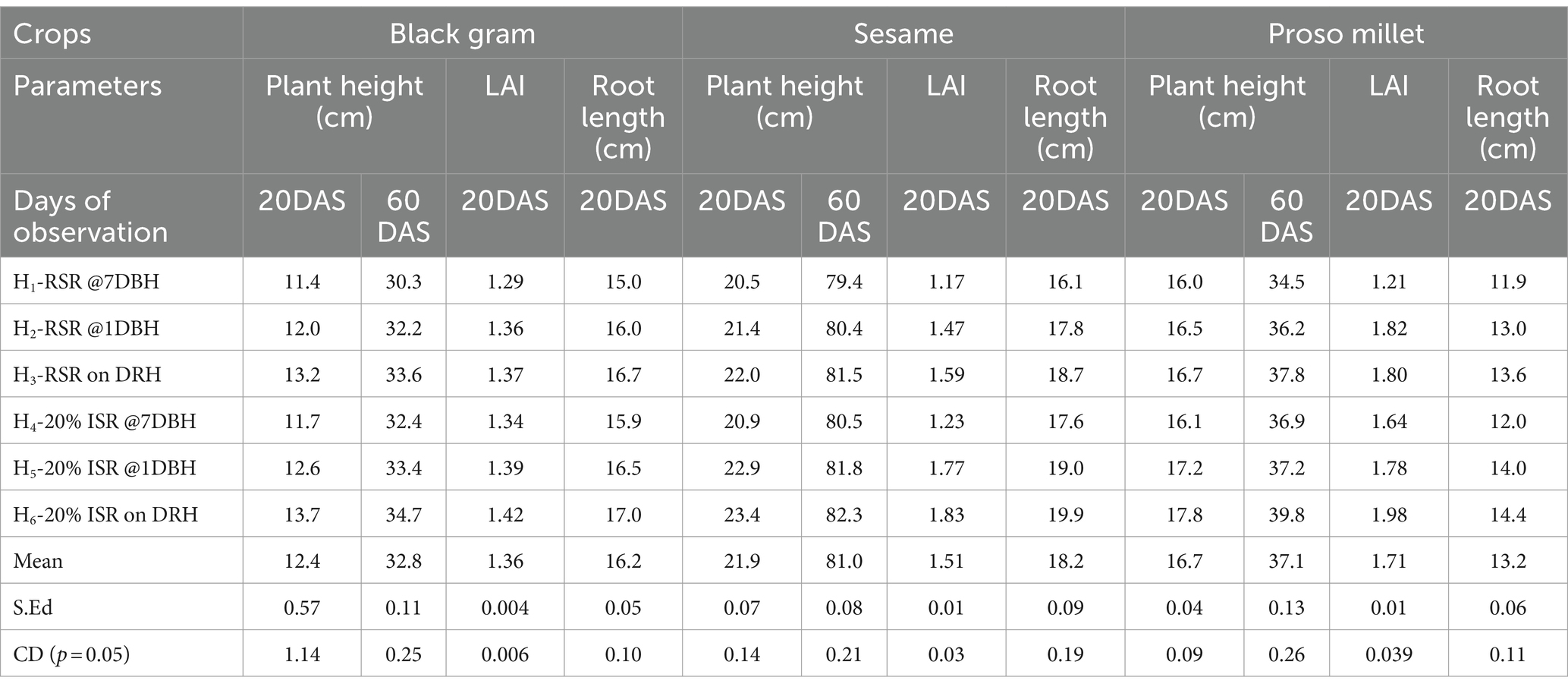
Table 1. Effect of seed rate and the time of sowing on the growth attributes of the rice fallow crops.
3.3 Yield attributes
The experimental results of the rice fallow crops in machine-harvested rice fields revealed that sowing black gram on the day of paddy harvest produced more pods plant−1 (13.7), followed by sowing a day before the harvest (10.2), which was similar to the normal seed rate on the day of the harvest. In the case of sesame, a greater number of capsules plant−1 was recorded when broadcast-seeded on the day of paddy harvest using a combine harvester (25.4 plant−1). For the proso millet, the maximum number of panicles was 5.0 plant−1, as observed during the paddy harvest using a combine harvester. The number of pods plant−1 varies significantly among different crop establishment methods, as lower populations per unit area may not favor per-plant yield parameters. Hence, the results indicate that plant density is an important characteristic for determining yield attributes under fallow conditions. This is due to the poor root establishment in plants that were sown before harvest and subjected to mechanical damage. No significant variation among the different treatments was observed for the number of seeds in pod-1, the number of seeds in capsule−1, or the number of seeds in panicle−1. As crops are grown on residual moisture under rainfed conditions, terminal drought severely affects crop productivity (Ali et al., 2014).
Among the rice fallow crops, black gram had the highest grain and haulm yields, with a mean grain yield of 493 kg ha−1 and a mean haulm yield of 826 kg ha−1. Sesame produced a mean grain yield of 243 kg ha−1 and a mean haulm yield of 392 kg ha−1. Proso millet produced a mean grain yield of 172 kg ha−1 and a mean straw yield of 434 kg ha−1. The grain and straw yields were greater when black gram was broadcast on the day of the paddy harvest using a combine harvester. The higher yield of black gram was due to the effective mechanical dibbling of seeds by the combine harvester on the day of the harvest, which resulted in less seed damage and better utilization of residual moisture for crop growth and development (Table 2). Poor yield was observed in proso millet seeds because they were subjected to terminal drought and poor root establishment due to increased bulk density caused by the trampling effect of the combine harvester.
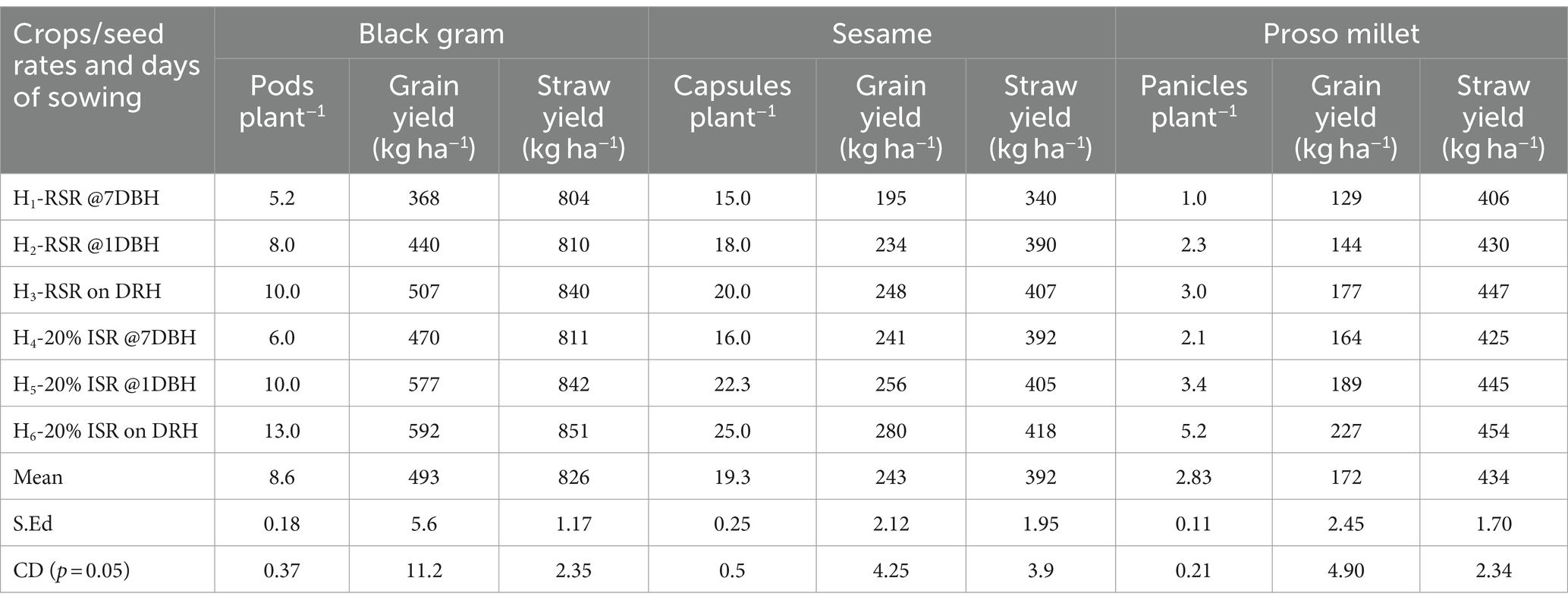
Table 2. Effect of seed rate and the time of sowing on the grain yield (kg ha−1) and straw yield (kg ha−1) of rice fallow crops.
3.4 Soil nutrient status
Appropriate inclusion of summer legume crops in cereal rotation systems is an important aspect of N and C management in fragile soils (Prasad and Nagarajan, 2004). Post-harvest soil analysis (Figure 4) revealed that the soil samples from the rice fallow black gram contained the highest quantity of nitrogen (239 kg ha−1), followed by sesame (199 kg ha−1) and proso millet (183 kg ha−1). Similar results were observed when cereal–cereal sequences were used for longer periods with low system productivity and often with poor crop management practices, resulting in a loss of soil fertility due to the emergence of multiple nutrient deficiencies (Dwivedi et al., 2017). A greater amount of available nitrogen in the soil was found in the soil samples from the rice fallow black gram plot because pulses can fix atmospheric nitrogen by nodulating bacteria. The soil samples from rice fallow, sesame, and proso millet did not have the same conditions. The inclusion of pulses in rice fallows can reduce the overall nitrogen (N) requirement for rice while increasing rice yield, residual N content, and total income from the land (Hariharan et al., 2022). Therefore, the experimental results revealed that rice fallow cultivation is an ideal practice in delta regions, where high yields and high incomes may be achieved under farming conditions.
Advancements in agriculture, such as mechanical harvesting of paddy, adversely affect rice fallow crops, and farmers are psychologically hesitant to cultivate rice fallow crops under these conditions. In this context, black gram has been found to be an ideal crop for machine-harvested rice fields. Sowing on the day of rice harvest resulted in mechanical dibbling with high germination, which is effective for both below- and above-ground growth and development. An increased seed rate of 20% is required to compensate for the mechanical damage caused by machine harvesting under fallow conditions. Black gram sown with a 20% (36 kg ha−1) increase in seed rate on the day of rice harvest was found to be the best combination for rice fallow crops in machine-harvested rice fields. The same approach can be recommended for delta areas where rice fallow crops are part of the traditional system. The inclusion of pulses in cereal-based crop rotations enhances input use efficiency and is considered a resource conservation technology.
Data availability statement
The original contributions presented in the study are included in the article/supplementary material, further inquiries can be directed to the corresponding authors.
Author contributions
DS: Conceptualization, Data curation, Formal analysis, Funding acquisition, Investigation, Methodology, Project administration, Resources, Software, Supervision, Validation, Visualization, Writing – original draft, Writing – review & editing. SE: Conceptualization, Data curation, Formal analysis, Investigation, Methodology, Project administration, Resources, Software, Supervision, Validation, Visualization, Writing – original draft, Writing – review & editing, Funding acquisition. AP: Data curation, Writing – review & editing, Conceptualization, Investigation, Methodology, Supervision. GA: Data curation, Validation, Writing – review & editing. BA: Project administration, Validation, Writing – review & editing. SG: Writing – review & editing. JK: Writing – review & editing. SA: Investigation, Resources, Supervision, Writing – review & editing.
Funding
The author(s) declare that no financial support was received for the research, authorship, and/or publication of this article.
Acknowledgments
We would like to acknowledge the Director of DEE, the Director of ATARI Zone X, the advisory committee members, staff members of KVK, Madurai, and the Department of Agronomy for their assistance during this study.
Conflict of interest
The authors declare that the research was conducted in the absence of any commercial or financial relationships that could be construed as a potential conflict of interest.
Publisher’s note
All claims expressed in this article are solely those of the authors and do not necessarily represent those of their affiliated organizations, or those of the publisher, the editors and the reviewers. Any product that may be evaluated in this article, or claim that may be made by its manufacturer, is not guaranteed or endorsed by the publisher.
References
Ali, M., Ghosh, P., and Hazra, K. (2014). “Resource conservation technologies in rice fallow” in Resource conservation technology in pulses. eds. P. K. Ghosh, N. Kumar, M. S. Venkatesh, K. K. Hazra, and N. Nadarajan (India: Scientific publishers), 83–88.
Amuthaselvi, G., Dhanushkodi, V., and Eswaran, S. (2019). Performance of zero till seed drill in raising blackgram under rice fallow. J. crop weed, 15, 195–197.
Bandyopadhyay, P., Singh, K., Mondal, K., Nath, R., Ghosh, P., Kumar, N., et al. (2016). Effects of stubble length of rice in mitigating soil moisture stress and on yield of lentil (Lens culinaris Medik) in rice-lentil relay crop. Agric. Water Manag. 173, 91–102. doi: 10.1016/j.agwat.2016.05.009
Black, C. A., Evans, D., White, J., Ensminger, L., and Clarke, F. (1965). Methods of soil analysis, vol. I. Madison, Wisconsin: ASA, 1–770.
Chandrasekaran, B., Annadurai, K., and Somasundaram, E. (2010). A textbook of agronomy. New Age International (P) Limited: New Delhi, 182.
Dwivedi, B., Singh, V., Shekhawat, K., Meena, M. C., and Dey, A. (2017). Enhancing use efficiency of phosphorus and potassium under different cropping systems of India. Indian J. Fertil 13, 20–41.
Gangopadhyay, S., Banerjee, R., Batabyal, S., Das, N., Mondal, A., Pal, S. C., et al. (2022). Carbon sequestration and greenhouse gas emissions for different rice cultivation practices. Sustain. Prod. Consum. 34, 90–104. doi: 10.1016/j.spc.2022.09.001
Gautam, P., Lal, B., Panda, B., Bihari, P., Chatterjee, D., Singh, T., et al. (2021). Alteration in agronomic practices to utilize rice fallows for higher system productivity and sustainability. Field Crop Res. 260:108005. doi: 10.1016/j.fcr.2020.108005
Geethika, J. D., Subramanian, E., Gurusamy, A., Arunachalam, P., Saliha, B. B., and Kumar, A. S. (2024). Sustainable Rice fallow crop production challenges and opportunities: an overview. Curr Agri Res. 12, 530–544. doi: 10.12944/CARJ.12.2.04
Gomez, K. A., and Gomez, C. M. (1984). Statistical procedures for agricultural research. New york: John Wiley and Sons Ine.
Gull, R., Bhat, T. A., Sheikh, T. A., Wani, O. A., Fayaz, S., Nazir, A., et al. (2020). Climate change impact on pulse in India-a review. J Pharmacogn Phytochem. 9, 3159–3166.
Hariharan, G., Abhayapala, R., Karunarathna, B., and Zakeel, M. C. M. (2022). “Efficient utilization of rice fallow through pulse cultivation” in Advances in Legumes for Sustainable Intensification (Cambridge, Massachusetts: Academic Press).
Hazra, K., and Bohra, A. (2021). Increasing relevance of pulse crops to sustainable intensification of Indian agriculture. Springer 44, 1–3. doi: 10.1007/s40009-020-00948-6
Kar, G., and Kumar, A. (2009). Evaluation of post-rainy season crops with residual soil moisture and different tillage methods in rice fallow of eastern India. Agric. Water Manag. 96, 931–938. doi: 10.1016/j.agwat.2009.01.002
Kumari, N., and Rahaman, S. (2021). Rice-fallows: a Destiny or opportunity to farmers from Bhagalpur District of Bihar
Olsen, S. R. (1954). Estimation of available phosphorus in soils by extraction with sodium bicarbonate : US Department of Agriculture.
Prasad, R., and Nagarajan, S. (2004). Rice–wheat cropping system–food security and sustainability. Curr. Sci. 87, 1334–1335.
Subrahmaniyan, K., Kumar, G. S., Subramanian, E., Raju, M., Veeramani, P., and Ravi, V. (2023). Crop establishment methods and moisture mitigation practices in rice fallow blackgram for productivity enhancement in Cauvery delta zone of Tamil Nadu. Legume Res. Int. J. 46, 502–505. doi: 10.18805/LR-4364
Keywords: blackgram, machine harvest, rice, rice fallow, sowing
Citation: Jaya Singh DG, Elangovan S, Paramasivam A, Arumugam G, Basir Ahmed BS, Gurunathan S, Krishnan J and Arumugam S (2024) Impact of seed rate and time of sowing on rice fallow crops and their sustainable production system in machine-harvested rice fields. Front. Sustain. Food Syst. 8:1495723. doi: 10.3389/fsufs.2024.1495723
Edited by:
Sudhir Kumar Rajpoot, Banaras Hindu University, IndiaReviewed by:
Pasoubady Saravanane, Pandit Jawaharlal Nehru College of Agriculture (PAJANCOA), IndiaManiyam Nedunchezhiyan, Central Tuber Crops Research Institute (ICAR), India
Copyright © 2024 Jaya Singh, Elangovan, Paramasivam, Arumugam, Basir Ahmed, Gurunathan, Krishnan and Arumugam. This is an open-access article distributed under the terms of the Creative Commons Attribution License (CC BY). The use, distribution or reproduction in other forums is permitted, provided the original author(s) and the copyright owner(s) are credited and that the original publication in this journal is cited, in accordance with accepted academic practice. No use, distribution or reproduction is permitted which does not comply with these terms.
*Correspondence: Subramanian Elangovan, ZXN1YnJhbWFuaWFuQHRuYXUuYWMuaW4=; Arunachalam Paramasivam, cGFydW5hY2hhbGFtQHRuYXUuYWMuaW4=
•ORCID: Subramanian Elangovan, https://orcid.org/0000-0003-2850-123x
Arunachalam Paramasivam, https://orcid.org/0000-0002-5359-811x
†These authors have contributed equally to this work and share first authorship
‡These authors share senior authorship
§These authors share last authorship
 Devi Geethika Jaya Singh1†
Devi Geethika Jaya Singh1† Subramanian Elangovan
Subramanian Elangovan